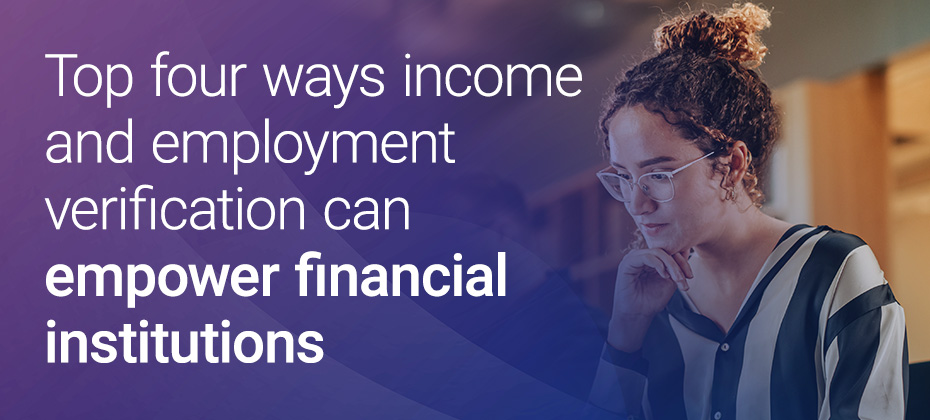Tag: business growth

As a community bank or credit union, your goal is to provide personalized care and attention to your customers and members while effectively managing regulatory requirements and operational efficiency. By incorporating tools such as income and employment verification, you can streamline the approval process for both account holders and prospects. With the ability to validate their information in seconds, you'll be able to make well-informed decisions faster and accelerate conversion. In this blog post, we will explore the empowering impact of income and employment verification on financial institutions. Better Data, Better Decisions Choosing a verification partner with an instant employer payroll network allows financial institutions to access reliable and up-to-date income and employment information for confident decision-making. With accurate and timely data at their fingertips, you can gain a deeper understanding of your account holders’ capacity to pay, a critical component to assessing overall financial health. This not only helps mitigate risk but also helps you serve your customers and members more effectively. There are additional benefits to partnering with a verification solution provider that is also a Credit Reporting Agency (CRA) offering FCRA-compliant technologies. These organizations are well versed in compliance matters and can help you more effectively mitigate risk. Streamline Approval Times and Remove Friction When developing your verification process, it is advantageous to adopt a waterfall or multi-step approach that encompasses instant verification, permissioned verification, and, as a last resort, manual verification. This tiered approach will significantly reduce approval times, manage costs effectively, and streamline the approval process. Instant verification relies on advanced technology to provide swift and efficient results. In cases where instant verification is unavailable, the process seamlessly transitions to permissioned verification, where explicit consent is obtained from individuals to access their payroll data directly from their respective providers. Lastly, manual verification involves collecting payroll and employment documents, which is a more time-consuming and costly process. By implementing this comprehensive approach, you can enhance the efficiency and effectiveness of your verification process while maintaining the integrity of the results. A Flexible Solution Community banks and credit unions are integral to the lending industry. It is crucial for them to select a versatile verification solution that can keep pace with the approval speed of both regional and large banks. Given that community banks and credit unions operate in smaller geographic regions compared to larger institutions, it is imperative for them to have a verification solution that is versatile and can be applied across their entire spectrum of loan offerings, including mortgage loans, automotive loans, credit cards, home equity loans, and consumer loans. This adaptability enables community banks and credit unions to consistently serve their account holders and enhances their ability to compete effectively with larger financial institutions. With a robust verification solution in place, community banks and credit unions can confidently navigate the complexities of the lending landscape and deliver exceptional results for their valued account holders. World-Class Service and Support To ensure a seamless verification journey, community banks and credit unions should choose a solution provider that delivers exceptional service and support. From the initial onboarding process and comprehensive training to ongoing troubleshooting and guidance, a dedicated and knowledgeable support team becomes indispensable in establishing a successful verification process. Having hands-on training and support not only instills peace of mind but also empowers community-focused financial institutions to consistently provide a high level of personalized service, fostering trust and loyalty among their customers and members. By investing in a robust support system, community banks and credit unions can confidently navigate the verification landscape and stay ahead in an ever-evolving financial industry, reinforcing their commitment to delivering an outstanding experience to their communities. As a longstanding leader in the financial industry, Experian understands the unique challenges faced by community banks and credit unions. Our verification solution, Experian VerifyTM, provides accurate, efficient, and compliant income and employment verification services. With Experian Verify, community focused financial institutions can navigate the complexities of income and employment verification with ease, achieving new levels of efficiency and success. To learn more about how Experian Verify can benefit your bank or credit union, we invite you to visit our website and schedule a personalized demo. Together, let's unlock the potential of income and employment verification and elevate your financial institution to new heights of success. Learn more

Growing deposits from existing customers and members is an ongoing priority for banks and credit unions. However, it can be challenging to identify the best candidates. Who among our customer base has significant deposit growth potential? Who among our member base has the financial capacity to take advantage of special offers? With an effective deposit growth strategy, you can find the best customers and members to engage. What does an effective deposit growth strategy look like? An effective bank and credit union deposit growth strategy is powered by differentiated data and digital engagement. Let’s take a closer look at each element: Data: A comprehensive measurement of consumers’ income and insights into their banking behaviors can help you identify those with the greatest deposit growth potential. You can then use supplemental data, such as lifestyle and demographic data, to customize deposit offers based on your customers or members’ unique needs. Digital engagement: To further personalize this experience, consider sending deposit offers through your mobile or online banking platforms when there are triggering events on their account. Not only does this optimize the digital experience, but it also helps boost the chances of your customers or members responding. Finding the right partner Experian’s solutions can help your business secure deposits and customer relationships in today’s crowded market, including Banking InsightsTM. Banking Insights provide greater visibility into integrated demand deposit account activity, such as checking and saving account inquiries, to help you better assess consumers’ financial stability. By using these insights to power your banking growth strategies, you can identify those with the financial capacity to bring in more deposits. Read our e-book to learn about other solutions that can help you boost deposits, strengthen existing relationships, and provide seamless digital experiences. Read e-book

In today’s evolving and competitive market, the stakes are high to deliver both quantity and quality. That is, to deliver growth goals while increasing customer satisfaction. OneAZ Credit Union is the second largest credit union in Arizona, serving over 157,000 members across 21 branches. Wanting to fund more loans faster and offer a better member experience through their existing loan origination system (LOS), OneAZ looked to improve their decisioning system and long-standing underwriting criteria. They partnered with Experian to create an automated underwriting strategy to meet their aggressive approval rate and loss rate goals. By implementing an integrated decisioning system, OneAZ had flexible access to data credit attributes and scores, resulting in increased automation through their existing LOS – meaning they didn’t have to completely overhaul their decisioning systems. Additionally, they leveraged software that enabled champion/challenger strategies and the flexibility to manage their decision criteria. Within one month of implementation, OneAZ saw a 26% increase in loan funding rates and a 25% decrease in manual reviews. They can now pivot quickly to respond to continuously evolving conditions. “The speed at which we can return a decision and our better understanding of future performance has really propelled us in being able to better serve our members,” said John Schooner, VP Credit Risk Management at OneAZ. Read our case study for more insight on how automation and PowerCurve Originations Essentials can move the needle for your organization, including: Streamlined strategy development and execution to minimize costly customizations and coding Comprehensive data assets across multiple sources to ensure ID verification and a holistic view of your prospect Proactive monitoring and real-time visibility to challenge and rapidly adjust strategies as needed Download the full case study

Lenders are under pressure to improve access to financial services, but can it also be a vehicle for driving growth? With the global pandemic and social justice movements exposing societal issues of equity, financial institutions are being called upon to do their part to address these problems, too. Lenders are increasingly under pressure to improve access to the financial system and help close the wealth gap in America. Specifically, there are calls to improve financial inclusion – the process of ensuring financial products and services are accessible and affordable to everyone. Financial inclusion seeks to remove barriers to accessing credit, which can ultimately help individuals and businesses create wealth and elevate communities. Activists and regulators have singled out the current credit scoring system as a significant obstacle for a large portion of U.S. consumers. From an equity standpoint, tackling financial inclusion is a no-brainer: better access to credit allows more consumers to secure safer housing and better schools, which could lead to higher-paying jobs, as well as the ability to start businesses and get insurance. Being able to access credit in a regulated and transparent way underpins financial stability and prosperity for communities and is key to creating a stronger economic system. Beyond “doing the right thing," research shows that financial inclusion can also fuel business growth for lenders. Get ahead of the game There is mounting regulatory pressure to embrace financial inclusion, and financial institutions may soon need to comply with new mandates. Current lending practices overlook many marginalized communities and low-income consumers, and government agencies are seeking to change that. Government agencies and organizations, such as the Consumer Financial Protection Bureau (CFPB) and Office of the Comptroller of the Currency (OCC), are requiring greater scrutiny and accountability of financial institutions, working to overhaul the credit reporting system to ensure fairness and equality. As a lender, it makes good business sense to tackle this problem now. For starters, as more institutions embrace Corporate Social Responsibility (CSR) mandates—something that's increasingly demanded by shareholders and customers alike—financial inclusion is a natural place to start. It demonstrates a commitment to CSR principles and creates a positive brand built on equity. Further, financial institutions that embrace these changes gain an early adopter advantage and can build a loyal customer base. As these consumers begin to build wealth and expand their use of financial products, lenders will be able to forge lifelong relationships with these customers. Why not get a head start on making positive organizational change before the law compels it? Grow your business (and profits) To be sure, financial inclusion is a pressing moral imperative that financial institutions must address. But financial inclusion doesn't come at the expense of profit. It represents an enormous opportunity to do business with a large, untapped market without taking on additional risk. In many instances, unscorable and credit invisible consumers exhibit promising credit characteristics, which the conventional credit scoring system does not yet recognize. Consider consumers coming to the U.S. from other countries. They may have good credit histories in their home countries but have not yet established a credit history here. Likewise, many young, emerging consumers haven't generated enough history to be categorized as creditworthy. And some consumers may simply not utilize traditional credit instruments, like credit cards or loans. Instead, they may be using non-bank credit instruments (like payday loans or buy-now-pay-later arrangements) but regularly make payments. Ultimately, because of the way the credit system works, research shows that lenders are ignoring almost 20 percent of the U.S. population that don't have conventional credit scores as potential customers. These consumers may not be inherently riskier than scored consumers, but they often get labelled as such by the current credit scoring system. That's a major, missed opportunity! Modern credit scoring tools can help fill the information gap and rectify this. They draw on wider data sources that include consumer activities (like rent, utility and non-bank loan payments) and provide holistic information to assist with more accurate decisioning. For example, Lift Premium™ can score 96 percent of Americans with this additional information—a vast improvement over the 81 percent who are currently scored with conventional credit data.1 By tapping into these tools, financial institutions can extend credit to underserved populations, foster consumer loyalty and grow their portfolio of profitable customers. Do good for the economy Research suggests that financial inclusion can provide better outcomes for both individuals and economies. Specifically, it can lead to greater investment in education and businesses, better health, lower inequality, and greater entrepreneurship. For example, an entrepreneur who can access a small business loan due to an expanded credit scoring model is subsequently able to create jobs and generate taxable revenue. Small business owners spend money in their communities and add to the tax base – money that can be used to improve services and attract even more investment. Of course, not every start-up is a success. But if even a portion of new businesses thrive, a system that allows more consumers to access opportunities to launch businesses will increase that possibility. The last word Financial inclusion promotes a stronger economy and thriving communities by opening the world of financial services to more people, which benefits everyone. It enables underserved populations to leverage credit to become homeowners, start businesses and use credit responsibly—all markers of financial health. That in turn creates generational wealth that goes a long way toward closing the wealth gap. And widening the credit net also enables lenders to uncover new revenue sources by tapping new creditworthy consumers. Expanded data and advanced analytics allow lenders to get a fuller picture of credit invisible and unscorable consumers. Opening the door of credit will go a long way to establishing customer loyalty and creating opportunities for both consumers and lenders. Learn more

If it looks like a bank and acts like a bank, there’s a good chance the company behind that financial services transaction may not actually be a bank – but a fintech. Born out of Silicon Valley, New York and tech hubs in between, fintechs have been categorically unfettered from regulation and driven by a focus on customer acquisition and revenue growth. Today, the fintech market represents hundreds of billions of dollars globally and has been disrupting financial services with the goal of delightful customer experiences and democratizing access to credit and banking. Their success has led many fintechs to update their strategy and growth targets and set their sites outside of core banking to other sectors including payments, alternative lending, insurance, capital markets, personal wealth management, alternative lending and others. Depending on the strategy, many are seeking a bank charter, or a partnership with a chartered financial institution to accomplish their new growth goals. Meanwhile, all this disruption has caught the attention of banks and credit unions who are keen to work with these marketplace lenders to grow deposits and increase fee-revenue streams. Historically, obtaining a bank charter was an onerous process, which led many fintechs to actively seek out partnerships with financial institutions in order to leverage their chartered status without the regulatory hurdles of becoming a bank. In fact, fintech and FI partnerships have boomed in the last few years, growing more than five times over the past decade. Gone are the days of the zero-sum game that benefits solely the bank or the fintech. Today, there are more than 30 partner banks representing hundreds of fintech relationships and financial services. These partnerships vary in size and scope from household names like Goldman Sachs, which powers the Apple credit card, to Hatch Bank, which has $68 million in assets and started with a single fintech partner, HM Bradley.[1] But which scenario is right for your fintech? Much of that depends on which markets and lines of business round out your growth strategy and revenue goals. Regardless of what framework you determine is right for your fintech, you need to work with partners who have access to the freshest data and models and a firm handle on the regulatory and compliance landscape. Experian can help you navigate the fintech regulatory environment and think through if partnering with a bank or seeking your own fintech charter is the best match for your growth plan. In the meantime, check out this new eBook for more information on the bank charter process and benefits, fintech-FI partnerships and the implications of the Office of the Comptroller of the Currency (OCC) new fintech charter. Read now Explore Fintech solutions [1] https://a16z.com/2020/06/11/the-partner-bank-boom/

The pandemic changed nearly everything – and consumer credit is no exception. Data, analytics, and credit risk decisioning are gaining an even more significant role as we grow closer to the end of the global crisis. Consumers face uneven roads to recovery, and while some are ready to spend again, others are still dealing with pandemic-related financial stress. We surveyed nearly 9,000 consumers and 2,700 businesses worldwide about how consumers are stabilizing their finances and businesses are returning to growth for our new Global Decisioning Report. In this report, we dive into: Key business priorities in 2021 Financial concerns for consumers How to navigate an uneven recovery Business priorities for the year ahead The importance of the online experience As we begin to near the end of the pandemic, businesses need to prioritize technology that enables a responsive, flexible, efficient and confident approach. This can be done by leveraging advanced data and analytics and integrating machine learning tools into model development. By investing in the right credit risk decisioning tools now, you can help ensure your future. Download the report

Account management is a critical strategy during any type of economy (pro-cycle, counter-cycle, cycle neutral). In times like these, marked by economic volatility, it is an effective way to identify which parts of your portfolio and which of your consumers need the most attention. Check out this podcast where Cyndy Chang, Senior Director of Product Management, and Craig Wilson, Senior Director of Consulting, discuss the foundational elements of account management, best practices and use cases. Account management today looks very different than what it has been during over a decade of growth proactive; account review is a critical part of navigating the path forward. Questions that need to be addressed include: Do you have the right data? Are you monitoring between data loads? Are you reviewing accounts at the frequency that today’s changing demands require? Listen in on the discussion to learn more. Experian · Look Ahead Podcast

With the growing need for authentication and security, fintechs must manage risk with minimal impact to customer experience. When implementing tactical approaches for fraud risk strategy operations, keeping up with the pace of fraud is another critical consideration. How can fintechs be proactive about future-proofing fraud strategies to stay ahead of savvy fraudsters while maintaining customer expectations? I sat down with Chris Ryan, Senior Fraud Solutions Business Consultant with Experian Decision Analytics, to tap into some of his insights. Here’s what he had to say: How have changes in technology added to increased fraud risk for businesses operating in the online space? Technology introduces many risks in the online space. As it pertains to the fintech world, two stand out. First, the explosion in mobile technology. The same capabilities that make fintech products broadly accessible makes them vulnerable. Anyone with a mobile device can attempt to access a fintech and try their hand at committing fraud with very little risk of being caught or punished. Second, the evolution of an interconnected, digital ‘marketplace’ for stolen data. There’s an entire underground economy that’s focused on connecting the once-disparate pieces of information about a specific individual stolen from multiple, unrelated data breaches. Criminal misrepresentations are more complete and more convincing than ever before. What are the major market drivers and trends that have attributed to the increased risk of fraud? Ultimately, the major market drivers and trends that drive fraud risk for fintechs are customer convenience and growth. In terms of customer convenience, it’s a race to meet customer needs in real time, in a single online interaction, with a minimally invasive request for information. But, serving the demands of good customers opens opportunities for identity misuse. In terms of growth, the pressure to find new pockets of potential customers may lead fintechs into markets where consumer information is more limited, so naturally, there are some risks baked in. Are fintechs really more at risk for fraud? If so, how are fintechs responding to this dynamic threat? The challenge for many fintechs has been the prioritization of fraud as a risk that needs to be addressed. It’s understandable that fintech’s initial emphasis had to be the establishment of viable products that meet the needs of their customers. Obviously, without customers using a product, nothing else matters. Now that fintechs are hitting their stride in terms of attracting customers, they’re allocating more of their attention and innovative spirit to other areas, like fraud. With the right partner, it’s not hard for fintechs to protect themselves from fraud. They simply need to acquire reliable data that provides identity assurance without negatively impacting the customer experience. For example, fintechs can utilize data points that can be extracted from the communications channel, like device intelligence for example, or non-PII unique identifiers like phone and email account data. These are valuable risk indicators that can be collected and evaluated in real time without adding friction to the customer experience. What are the major fraud risks to fintechs and what are some of the strategies that Risk Managers can implement to protect their business? The trends we’ve talked about so far today have focused more on identity theft and other third-party fraud risks, but it’s equally important for fintechs to be mindful of first party fraud types where the owner of the identity is the culprit. There is no single solution, so the best strategy recommendation is to plan to be flexible. Fintechs demonstrate an incredible willingness to innovate, and they need to make sure the fraud platforms they pick are flexible enough to keep pace with their needs. From your perspective, what is the future of fraud and what should fintechs consider as they evolve their products? Fraud will continue to be a challenge whenever something of value is made available, particularly when the transaction is remote and the risk of any sort of prosecution is very low. Criminals will continue to revise their tactics to outwit the tools that fintechs are using, so the best long-term defense is flexibility. Being able to layer defenses, explore new data and analytics, and deploy flexible and dynamic strategies that allow highly tailored decisions is the best way for fintechs to protect themselves. Digital commerce and the online lending landscape will continue to grow at an increasing pace – hand-in-hand with the opportunities for fraud. To stay ahead of fraudsters, fintechs must be proactive about future-proofing their fraud strategies and toolkits. Experian can help. Our Fintech Digital Onboarding Bundle provides a solid baseline of cutting-edge fraud tools that protect fintechs against fraud in the digital space, via a seamless, low-friction customer experience. More importantly, the Fintech Digital Onboarding Bundle is delivered through Experian’s CrossCore platform—the premier platform in the industry recognized specifically for enabling the expansion of fraud tools across a wide range of Experian and third-party partner solutions. Click here to learn more or to speak with an Experian representative. Learn More About Chris Ryan: Christopher Ryan is a Senior Fraud Solutions Business Consultant. He delivers expertise that helps clients make the most from data, technology and investigative resources to combat and mitigate fraud risks across the industries that Experian serves. Ryan provides clients with strategies that reduce losses attributable to fraudulent activity. He has an impressive track record of stopping fraud in retail banking, auto lending, deposits, consumer and student lending sectors, and government identity proofing. Ryan is a subject matter expert in consumer identity verification, fraud scoring and knowledge-based authentication. His expertise is his ability to understand fraud issues and how they impact customer acquisition, customer management and collections. He routinely helps clients review workflow processes, analyze redundancies and identify opportunities for process improvements. Ryan recognizes the importance of products and services that limit fraud losses, balancing expense and the customer impact that can result from trying to prevent fraud.

From a capricious economic environment to increased competition from new market entrants and a customer base that expects a seamless, customized experience, there are a host of evolving factors that are changing the way financial institutions operate. Now more than ever, financial institutions are turning to their data for insights into their customers and market opportunities. But to be effective, this data must be accurate and fresh; otherwise, the resulting strategies and decisions become stale and less effective. This was the challenge facing OneMain Financial, a large provider of personal installment loans serving 10 million total customers across more than 1,700 branches—creating accurate, timely and robust insights, models and strategies to manage their credit portfolios. Traditionally, the archive process had been an expensive, time-consuming, and labor-intensive process; it can take months from start to finish. OneMain Financial needed a solution to reduce expenses and the time involved in order to improve their core risk modeling. In this recent IDC Customer Spotlight, sponsored by Experian, "Improving Core Risk Modeling with Better Data Analysis," Steven D’Alfonso, Research Director spoke with the Senior Managing Director and head of model development at OneMain Financial who turned to Experian’s Ascend Analytical Sandbox to improve its core risk modeling through reject inferencing. But OneMain Financial also realized additional benefits and opportunities with the solution including compliance and economic stress testing. Read the customer spotlight to learn more about the explore how OneMain Financial: Reduced expense and effort associated with its archive process Improved risk model development timing from several months to 1-2 weeks Used Sandbox to gain additional market insight including: market share, benchmarking and trends, etc. Read the Case Study

New industry report highlights the convergence of business growth and fraud prevention strategies Experian has published its first annual global fraud report covering the convergence of growth strategies and fraud prevention. The report, Global Business Trends: Protecting Growth Ambitions Against Rising Fraud Threats, is designed as a guide for senior executives and fraud prevention professionals, offering new insights on how the alignment of strategies for business growth and fraud prevention can help a business grow revenues while managing risks in an increasingly virtual world. The report identifies five trends that businesses should assess and take action on to mitigate fraud and improve the customer experience in today's fast-paced, consumer-centric environment: Applying right-sized fraud solutions to reduce unnecessary customer disruption: It's time to move on from a one-size-fits-all approach that creates more customer friction than necessary. Instead, companies should apply fraud solutions that reflect the value and level of confidence needed for each transaction. This means right-sizing your fraud solutions to align with true fraud rates and commercial strategy. Having a universal view of the consumer is the core of modern fraud mitigation and marketing: Achieving a universal profile of consumer behavior — beyond the traditional 360-degree view — requires access to a combination of identity data, device intelligence, online behavior, biometrics, historical transactions and more, for consumer interactions not only with you, but across other businesses and industries as well. Companies that translate this knowledge and use it to identify consumers can distinguish a fraudster from a real customer more easily, building trust along the way. Expanding your view through a blended ecosystem: In addition to using your own first-party data sources, companies need to participate in a blended ecosystem, working across businesses and even industries. Fraudsters have access to more data than ever before, including data traditionally used to verify identities, and they use that data to create an entire digital profile. Therefore, you can no longer get to the digital interaction data you need by managing the process in a siloed manner. Achieving an expansive view of the universal consumer requires multiple data sources working together. Achieving agility and scale using service-based models: Today, more and more companies are choosing subscription-based systems rather than building in-house or implementing on-premise solutions. Continuous upgrades and the access to new risk logic that come with subscription models provide more agility and faster response to emerging threats, no matter how fast your volume grows or what products, channels or geographies you pursue. Future-proofing fraud solution choices: Companies need access to a wide variety of traditional and emerging technologies and information sources to fill in knowledge gaps and blind spots where fraudsters try to hide. The ability to modify strategies quickly and catch fraud faster while improving the customer experience is a critical aspect of fraud prevention moving forward. Bringing together these key trends, the report provides business leaders with the insight they need to fight fraud using the same consumer-focused approach currently being used to attract new customers and grow revenue. "There is a persistent mindset that fraud loss is just the cost of doing business," said Steve Platt, global EVP, Fraud and Identity, Experian. "But as fraudsters evolve, those losses are climbing, and the status quo is no longer effective or acceptable. We all need to be as forward-looking in fighting fraud as we are in business operations and marketing, and a real understanding of consumers is critical for success. We're talking about the convergence of business growth and fraud prevention, and we're pleased to provide the first report in the marketplace covering this topic." Download the full report here. The report also features an interactive Fraud Prevention Benchmark tool that companies can use to explore how these trends impact their business and how the performance of their approach measures up against industry practices. The report is relevant to functions spanning the enterprise, including C-suite executives such as chief marketing officers (CMOs), chief risk officers (CROs) and chief data officers (CDOs). The report focuses on business processes where fraud infiltrates, including new account opening, account access, money movement transactions, and emerging trends combating fraud, such as advanced fraud analytics. In each area, the report details how multiple business functions can apply responses to create business growth. Steve Platt added: "We hear from our clients that they are most successful when CMOs along with CDOs and CROs all work together to understand the customer and develop fraud management solutions that create a better overall experience." Experian was recently cited in Forrester's 2016 Vendor Landscape: Mobile Fraud Management Solutions1 report and listed as having nine out of a possible 10 capabilities needed to combat mobile fraud. Experian was also identified as one of three leading players in the fraud detection and prevention space in a new study from Juniper Research.2 Experian applied best practices to create a global report on providing fraud management solutions that allow companies to maximize profitability while providing secure, hassle-free customer interactions. Learn more about Experian’s Fraud and Identity business. 1Vendor Landscape: Mobile Fraud Management Solutions, Forrester Research, Inc., June 2016. 2Online Payment Fraud: Key Vertical Strategies & Management 2016–2020, Juniper Research, June 2016.